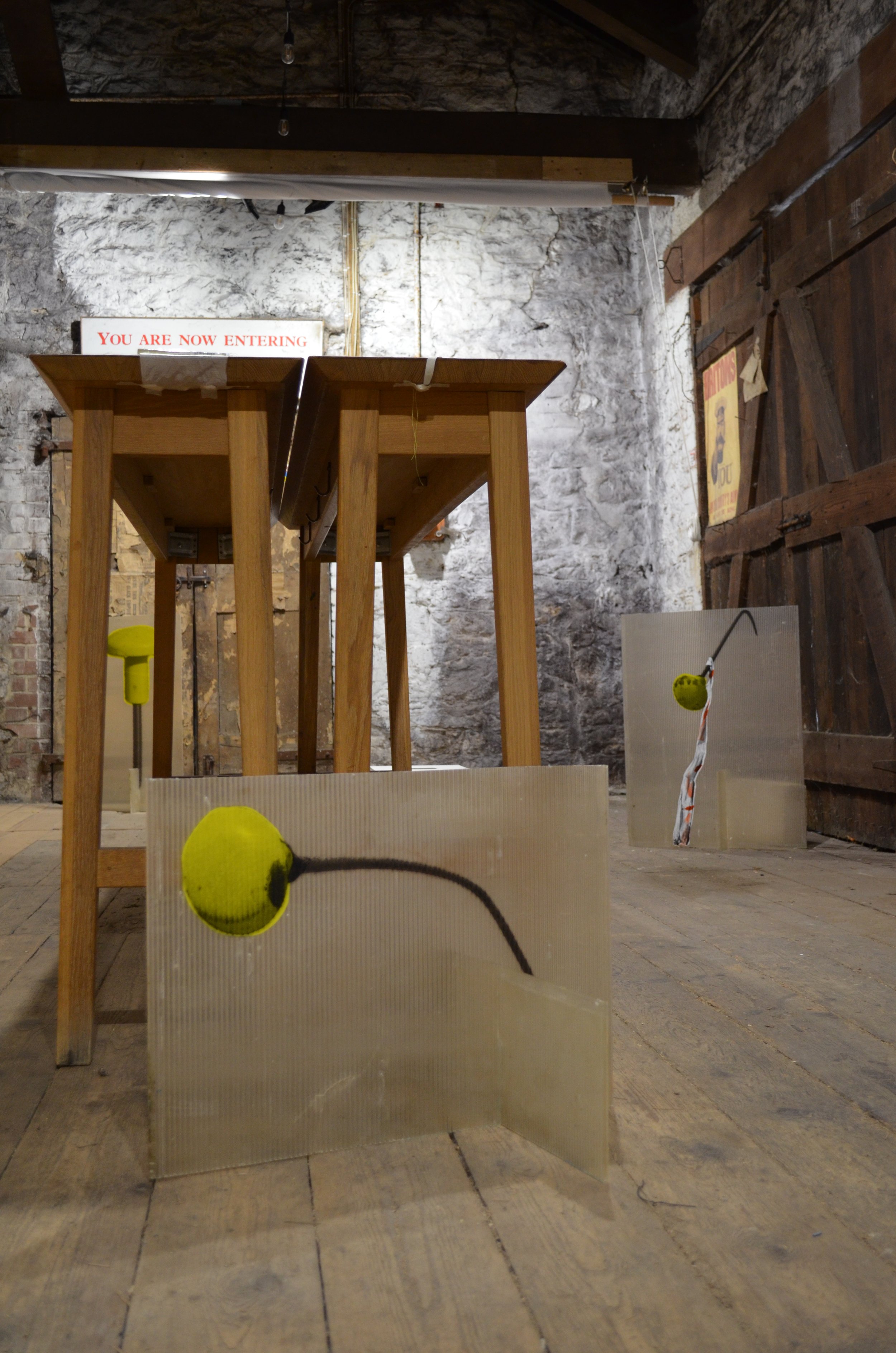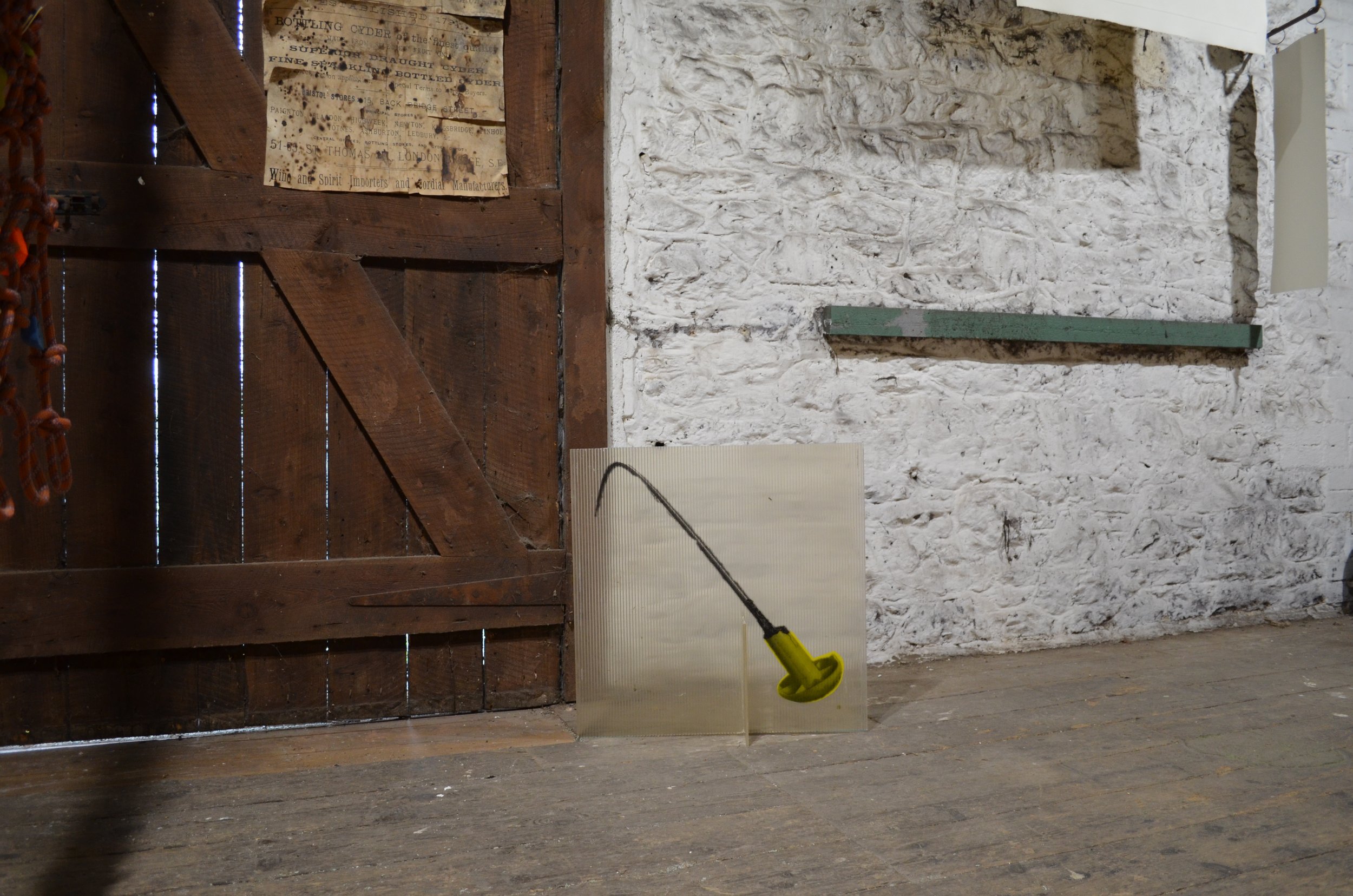Through Line
〰️
INFO
📍
#CampExeterKin
〰️
Through Line 〰️ INFO 📍 #CampExeterKin 〰️
Artists
1 Penny Simons
Using the Discarded. (2024) Paper
The two pieces here grew from my delight in the delicate, slightly shiny paper wrapped around a postal delivery and the creases and folds created by this packaging, which I have picked out in stitch. Because of its fragility one piece is mounted onto a heavyweight paper using fairly toxic glue, which points out the difficulty of remaining ecologically sound! Its a work in progress.
2 Gabrielle Hoad & Megan Calver
The whistle draws attention to the signal, 2024. Painted objects, tool clips, lanyards, whistles.
Drawing on images from bird identification and railway signalling manuals, these painted objects reimagine human-avian interactions in the local environment. Designed as tools for coordinating sound and movement, they invite reflection on ideas of joining in, taking turns and playing by the rules.
Frequent collaborators since 2015, Gabrielle Hoad and Megan Calver share an interest in generating site-responsive work through oblique approaches to field study. Undertaking investigation of places and their inhabitants in a spirit of imaginative rather than empirical discovery, their approach often draws on the input of human and nonhuman participants.
3 Janet Sainsbury
Camp Currency, 2024. Ink on tracing paper.
The subject of money and artist’s pay has been a recurring theme running through Exeter Camp conversations. The ‘Camp Currency’ £2.60 notes were made in response to these discussions; the amount is based upon the median amount per hour an artist working in the UK is paid.*
The notes feature portraits of an eclectic range of women writers and artists, which reflects the subjects depicted in my wider creative practice. Alongside figures from the last century, there are also contemporary names: Shelagh Delaney, Barbara Hepworth, Katherine Mansfield, Hilary Mantel, Lee Miller, Edna O’Brien, Paula Rego, Zadie Smith, Rita Tushingham, Virginia Woolf.
*Industria and a-n The Artists Information Company, 2023.
4 Stella Tripp
Drawing A Line, 2024. Yarn, thread, recycled fabrics, packaging and inner tubes
This piece grew out of thoughts about lines and surfaces, how they interact and what effect they have on each other – and then it just carried on growing. To start with I thought I was making a long surface to paint or draw lines on, but then the stitched lines appeared as an integral part of the surface and the making. It felt as if I was enabling the materials to do what they wanted – without even being able to see the result as it is too long to see in full in my studio.
5 Catherine Cartwright
Portrait Key Rings, 2024. Rubber-stamped found cardboard.
Some 90 miniature portraits hang like hotel key rings. This work is an emotional response to the continuing sexual exploitation of women and girls. Each ‘portrait’ has been printed from a carved rubber stamp. And each ‘portrait’ has been drawn (and then carved) from the same photograph by Adriana Lestido from her series of photographs (Mujeres Presas/Imprisoned Women 1991-1993) depicting incarcerated women in Argentina. I am interested in how my depictions differ, the portraits suggesting both a universal and individual representation of exploited women. This is a work in progress which may develop into a larger installation.
6 Frances Williams
No Place I Know: Scenes from the ballad of Maltster Pete, 2024. Digital photographs, collage.
The interior of the malthouse barn and its redundant fixtures and fittings, a decaying industrial ruin, is haunted by ghosts of barley, and stories told in the cobwebs and discarded museum props scattered on the maltings floor. These ruins are reimagined in the form of constructed scenes for an experimental fictive performance to form an uncertain and unreliable narrative.
7 Jane Jobling
Malt Furrow, 2024. Paper and Wire
Malt Furrow hints at the shapes made in the malt by hand raking. The slow movement of the elements are informed by the unhurried, gentle practice that was carried out at The Maltings Taphouse for over 100 years.
8 Adam Garratt
Point of interest, 2024. Screen printed plastic sheeting.
The printed material and images in this work were collected close to the railway line between Exeter and Newton Abbot. While thinking about the places that can be accessed on the picturesque stretch of track this work draws attention to human intervention in the space. From fly tipped plastics outside busy stations to landscape interventions that hold sand dunes in place on popular tourist beaches.
The yellow headed pins protrude from the golden sand like a pin in a map or a wildflower.
9 Sue Wyllie
Cherish, 2024. Photopolymer duotone
This is an attempt to touch a singularity in the botanical process that once gave this now disused space life.
10 Francesca Giuliano
Tide: Broad Band, 2024. Fabric, packaging, card, paper, thread. 33m x 14cm approx.
Tide: Narrow Band (2022-2024) Fabric, packaging, card, paper, thread. 35m x 2cm approx.
These two pieces are part of a series I have been exploring recently called Tide. The series examines a concern with the tide of materials that we consume and discard. As a small representational effort I am attempting to use up all the materials I have in my studio and that pass through my life, like textiles and food packaging. I envisage adding to these two pieces over time, in fact they may never be finished.
11 Sarah Bennett
Lost objects, 2024
The cavernous space at Tucker’s Maltings has long been empty of barley, but by rummaging around various objects can be found, mainly rusty and dirty old tools: a grain rake, two grain riddles, a grain conveyer belt. These abandoned items each take on a new presence when placed in strong directional light of the malthouse. Photographed as digital images then converted to 35mm slides and shown in handheld viewers, the visitor can glimpse something of these eloquent objects.
A looped video ‘Riddle’ (shown on 13, 21 and 28 July,) captures one of the grain riddles rolling precariously from side to side, accompanied by the muffled sound of trains rumbling up and down the adjacent line..
12 Erika Cann
Winnowing, 2024. Rope, belemnites, hagstones, climbing holds, found objects
The net acts as a holding space for unlikely bodies that meet when sifted and separated from the land. Intertwined with the harvest, the chaff clings on, forming mineralogical, biological and folkloric exchanges. Deep-time bodies become protectors of the crop, mineral beings neutralise the soil, and fragments of matter feed the ecosystem. Unfamiliar objects insert themselves into the field, omnipresent in the landscape, searching for their own dialogues as anthropological husks.
13 Alice Clough
Gentler, 2024. Hand-cut debossing on paper.
Unhurried, 2024. Hand-cut debossing on paper.
A spell is an utterance, a tale told, wordplay with magical power. Taken from a description of the malting process at Tuckers Maltings, these are the first pieces in a Spell series that will explore the enchantment of words and the impressing of meaning.
Through Line brings together 14 members of CAMP who live in or near Exeter in an exhibition that marks one year since the group started working together. They are an active cohort of artists who regularly meet, make, and discuss work. This support network has culminated in a burst of creative making that is presented at this exhibition in Newton Abbot. Through Line has given the opportunity to make new work or finish an existing work with group dynamics in mind. The exhibition space sits trackside to Newton Abbot’s railway line, a physical through line between Exeter and Plymouth. Serving as a connecting point between 2 of the larger factions of CAMP’s activity in Devon.
The artists may respond to the unique industrial gallery space, its history and its many unique details or the railway line itself. They may respond to cohort activity leading up to the exhibition, such as studio visits, organised walks, or collaborative works.
From printed works and blind debossing to assemblages and performative actions this exhibition showcases just some of the rich creative practice taking place in Devon.
Through Line Artists. (minus one)





























